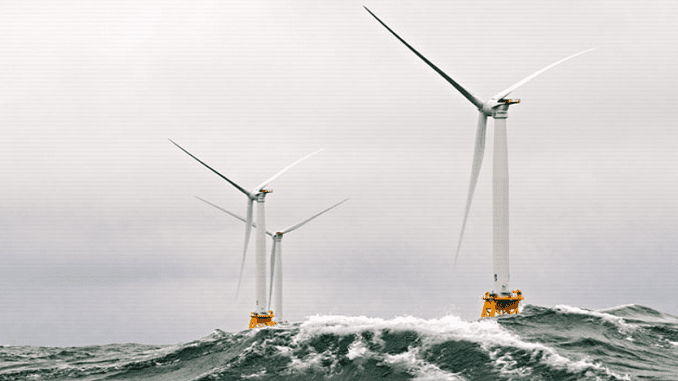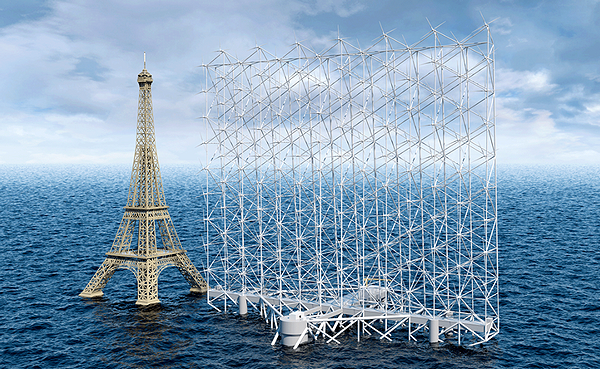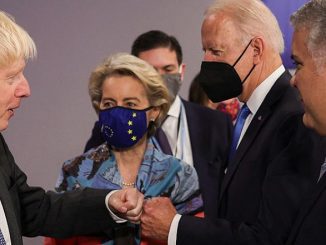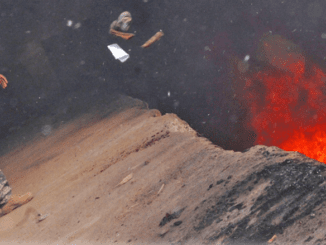
WASHINGTON, DC, September 16, 2022 (ENS) – The Biden Administration is launching a fleet of coordinated actions to develop floating offshore wind platforms, an emerging clean energy technology that will help the United States lead on offshore wind. Called the “Floating Offshore Wind Shot,” the new program will capture this potential to power millions of homes and businesses, grow new manufacturing and maritime industries, and tackle the climate crisis.
Conventional offshore wind turbines can be secured directly to the sea floor in shallow waters near the East Coast and the Gulf of Mexico. But areas where the ocean is too deep to anchor turbines with cables require floating platforms for the turbines. These deep water areas hold two-thirds of America’s offshore wind energy potential, especially along the West Coast and in the Gulf of Maine.
Announcing the new program on Thursday, the White House said, “America will seize this opportunity to be a frontrunner on floating offshore wind technologies, as part of President Biden’s plan for a clean energy economy built by American workers.”
The Floating Offshore Wind Shot initiative is led by the Departments of Energy, DOE, Interior, Commerce, and Transportation. DOE and the National Science Foundation will collaborate on research and workforce development in support of the new program.
White House National Climate Advisor Gina McCarthy, Energy Secretary Jennifer Granholm, and Interior Secretary Deb Haaland joined state officials to announce the Floating Offshore Wind Shot.
The announcement Thursday was McCarthy’s last high-profile official act as White House National Climate Advisor. The climate policy leader and former U.S. EPA chief stepped down today and will be replaced by John Podesta, former President Bill Clinton’s chief of staff and a leader on Hillary Clinton’s presidential campaign, President Joe Biden announced on September 2.
Floating Offshore Wind Shot Aims to Lower Tech Costs
Through the Department of Energy’s existing Energy Earthshot program, started last year, the administration will create the new Floating Offshore Wind Shot initiative to accelerate breakthroughs across engineering, manufacturing, and other innovation areas.
The Floating Offshore Wind Shot will aim to reduce the costs of floating technologies by more than 70 percent by 2035, to $45 per megawatt-hour.
Building on the President’s existing goal of deploying 30 gigawatts, GW, of offshore wind by 2030, which will be largely met using fixed-bottom technology, the administration has set a new goal – to reach 15 GW of floating wind capacity by 2035. The government will advance lease areas in deep waters to deploy 15 GW of floating offshore wind capacity by that date – 13 years from now.

To support these goals, this week the administration launched a new prize competition for floating offshore wind platform technologies; initiatives funded by the Bipartisan Infrastructure Law to develop modeling tools for project design and to analyze port needs; and other funding for research, development, and demonstration efforts.
These new goals, initiatives, and investments focus on floating technologies and build on the administration’s all-of-government approach to developing offshore wind while advancing environmental justice, protecting biodiversity, and promoting ocean co-use.
Through the Inflation Reduction Act, President Biden secured clean energy tax credits that will further accelerate this new American industry and a thriving domestic supply chain, with support for Made in America wind turbine blades, fixed-bottom and floating platforms, installation and service vessels.
“Achieving this ambitious target will spur billions of dollars of economic opportunities and avoid an estimated 26 million metric tons of carbon emissions annually,” the White House said in a statement about the new program.
$50M to Get Floating Offshore Wind Shot Off the Ground
To support these ambitious new goals on floating offshore wind, the Department of Energy, DOE, announced nearly $50 million, including support from the Bipartisan Infrastructure Law, for research, development, and demonstration funding:
Floating Offshore Wind Readiness Prize: This week, DOE announced a $6.85 million prize competition that challenges competitors to optimize floating platform technologies and work to get them ready for wide-scale domestic manufacturing and commercialization.
Floating Offshore Wind Array Design Project: DOE announced a $3 million project funded by the Bipartisan Infrastructure Law to develop a set of modeling tools to help industry and researchers design commercial-scale floating offshore wind farm arrays in U.S. waters, including their anchors, mooring lines, and subsea power cables.
West Coast Ports Analysis: DOE announced a nearly $1 million project funded by the Bipartisan Infrastructure Law to reduce key infrastructure challenges by outlining a network of West Coast ports and upgrades needed to deploy commercial-scale floating offshore wind.
West Coast Transmission Analysis: DOE announced an analysis to review existing transmission studies and identify research gaps related to offshore wind integration in California, Oregon, and Washington. This work will help inform future analysis efforts that will aid in transmission planning and buildout.
Atlantis II: DOE’s Advanced Research Projects Agency-Energy: ARPA-E intends to announce $31 million in funding through phase two of its Aerodynamic Turbines, Lighter and Afloat, with Nautical Technologies and Integrated Servo-control, ATLANTIS, program. The ATLANTIS program focuses on novel forms of systems engineering for floating offshore wind systems to drive down costs. This second phase of the ATLANTIS program will focus on experimental testing in ocean, lake, and tank and tunnel environments to further develop new technology for floating offshore wind turbines.
Environmental Research Award: DOE and BOEM announced a $1.6 million project to support coexistence of floating offshore wind with bats on the West Coast of the United States.
Ocean Co-Use and Transmission Research Awards: The National Offshore Wind R&D Consortium, a partnership established with funding from DOE and the New York State Energy Research and Development Authority, announced five projects totaling $3.5 million to facilitate ocean area coexistence with marine mammals and fishing and to support offshore wind transmission for both fixed-bottom and floating technologies.
The White House sees floating offshore wind as a major opportunity for the United States economy, saying, “Globally, only 0.1 GW of floating offshore wind has been deployed to date, compared with over 50 GW of fixed-bottom offshore wind. Today’s actions will position the U.S. to lead the world on floating offshore wind technology.”
In August, the Department of Energy Wind Energy Technologies Office released the “Offshore Wind Market Report: 2022 Edition,” co-authored by several researchers at the National Renewable Energy Lab. The report details information on the global and domestic offshore wind industry to provide current data and trends to help readers navigate technical and market barriers and opportunities.
Featured image: Floating offshore wind turbines generate power in deep ocean waters where winds are the strongest. (Photo courtesy U.S. National Renewable Energy Laboratory)
© 2022, Environment News Service. All rights reserved. Content may be quoted only with proper attribution and a direct link to the original article. Full reproduction is prohibited.



